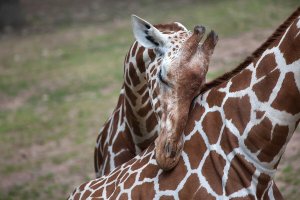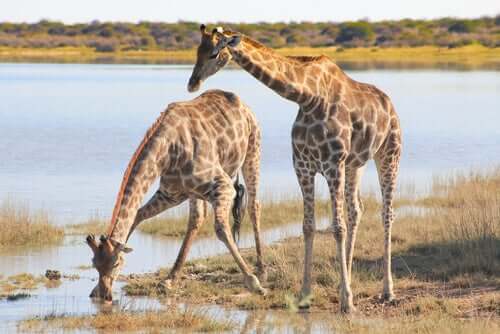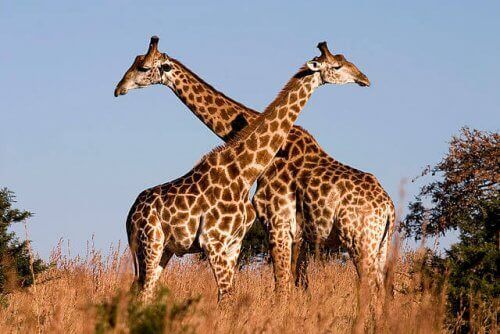The Giraffe: Characteristics, Behavior, and Habitat

The giraffe is the tallest mammal on the entire planet. The length of its neck and legs is very striking from the first time you see it. And, like the zebra, it has a very attractive skin that, undoubtedly, has inspired many designers to imitate its different patterns.
This is a herbivorous animal whose neck can measure up to six feet (two meters) long. However, the rest of its characteristics are equally curious. Below, we’ll discuss some of the most important ones.
Characteristics of the giraffe
Weight and length
The long neck of the giraffe helps it feed on tree leaves and clean itself. However, this isn’t the only tool available to this animal; it also has a very long tongue. It can measure up to 11 to 20 inches (50-53 centimeters) and is a purple-black color. Giraffes use their tongues to take food and bring it to their mouths.
The giraffe’s legs are longer than the height of many human adults, as they can measure up to 5.9 feet (1.80 meters). Even though this may seem like a great advantage in terms of escaping from possible predators, the giraffe can only walk and gallop at a speed of between 27 and 31 miles per hour (50 to 60 kilometers per hour).
Regarding its size and weight, its body measures between 12.4 and 15.4 feet (3.8 and 4.7 meters). To this, we must add the tail, which ranges from between 30 to 39 inches (78 to 100 centimeters). Males are taller than females and usually weigh around 2620 to 3520 pounds (1200 to 1600 kg). Females usually weigh approximately 1650 to 1820 pounds (750 to 825 kg).

Curiosities
On their heads, giraffes have a pair of “horns” called ossicones. It’s a kind of cartilage that’s usually much more pronounced in males than in females. Another curious fact is that male giraffes can have a much stronger odor than females. It’s believed that this scent helps them attract mates during the breeding season.
Also, the coat is short and brown, mottled with dark brown spots. The pattern of the spots is defined when the giraffe is a calf and, subsequently, it mates according to the similarity of the coat pattern. As for the hair, it’s quite short and erect.
The four giraffe species are:
- Camelopardalis.
- Reticulated giraffe
- Massai giraffe
- Southern giraffe
Unfortunately, West African giraffes, namely those belonging to the species Giraffa camelopardalis, are in danger of extinction. They stand out because their spots are more reddish and they have a lighter coat. This contrast is really striking.
The main reason why the West African giraffe is endangered is the destruction of its habitat. However, there are also other causes, such as poaching (mainly as a hobby and for their coat) and civil unrest in various regions.
Habitat and behavior
Giraffes live in African meadows, savannahs, forests, and grasslands. They usually live in herds of up to 20 and no less than 6. Most of these herds consist of females and a young male. However, it’s noteworthy that families change per hour. While the mother stays with her calves for a whole year, after this time the rotation starts.

Males fight among themselves to be the leader through necking (the neck is used as a weapon). In addition, they emit sounds that are similar to cow moos. This way, they notify each other if a predator is approaching. Female giraffes also resort to this sound to call their calves if they get lost.
Usually, the giraffe is a shy animal that tries to avoid confrontation. But, if it’s cornered, threatened, or sees that its calves are in danger, it gives kicks that can be fatal due to the weight and strength of their legs.
The giraffe is the tallest mammal on the entire planet. The length of its neck and legs is very striking from the first time you see it. And, like the zebra, it has a very attractive skin that, undoubtedly, has inspired many designers to imitate its different patterns.
This is a herbivorous animal whose neck can measure up to six feet (two meters) long. However, the rest of its characteristics are equally curious. Below, we’ll discuss some of the most important ones.
Characteristics of the giraffe
Weight and length
The long neck of the giraffe helps it feed on tree leaves and clean itself. However, this isn’t the only tool available to this animal; it also has a very long tongue. It can measure up to 11 to 20 inches (50-53 centimeters) and is a purple-black color. Giraffes use their tongues to take food and bring it to their mouths.
The giraffe’s legs are longer than the height of many human adults, as they can measure up to 5.9 feet (1.80 meters). Even though this may seem like a great advantage in terms of escaping from possible predators, the giraffe can only walk and gallop at a speed of between 27 and 31 miles per hour (50 to 60 kilometers per hour).
Regarding its size and weight, its body measures between 12.4 and 15.4 feet (3.8 and 4.7 meters). To this, we must add the tail, which ranges from between 30 to 39 inches (78 to 100 centimeters). Males are taller than females and usually weigh around 2620 to 3520 pounds (1200 to 1600 kg). Females usually weigh approximately 1650 to 1820 pounds (750 to 825 kg).

Curiosities
On their heads, giraffes have a pair of “horns” called ossicones. It’s a kind of cartilage that’s usually much more pronounced in males than in females. Another curious fact is that male giraffes can have a much stronger odor than females. It’s believed that this scent helps them attract mates during the breeding season.
Also, the coat is short and brown, mottled with dark brown spots. The pattern of the spots is defined when the giraffe is a calf and, subsequently, it mates according to the similarity of the coat pattern. As for the hair, it’s quite short and erect.
The four giraffe species are:
- Camelopardalis.
- Reticulated giraffe
- Massai giraffe
- Southern giraffe
Unfortunately, West African giraffes, namely those belonging to the species Giraffa camelopardalis, are in danger of extinction. They stand out because their spots are more reddish and they have a lighter coat. This contrast is really striking.
The main reason why the West African giraffe is endangered is the destruction of its habitat. However, there are also other causes, such as poaching (mainly as a hobby and for their coat) and civil unrest in various regions.
Habitat and behavior
Giraffes live in African meadows, savannahs, forests, and grasslands. They usually live in herds of up to 20 and no less than 6. Most of these herds consist of females and a young male. However, it’s noteworthy that families change per hour. While the mother stays with her calves for a whole year, after this time the rotation starts.

Males fight among themselves to be the leader through necking (the neck is used as a weapon). In addition, they emit sounds that are similar to cow moos. This way, they notify each other if a predator is approaching. Female giraffes also resort to this sound to call their calves if they get lost.
Usually, the giraffe is a shy animal that tries to avoid confrontation. But, if it’s cornered, threatened, or sees that its calves are in danger, it gives kicks that can be fatal due to the weight and strength of their legs.
This text is provided for informational purposes only and does not replace consultation with a professional. If in doubt, consult your specialist.








